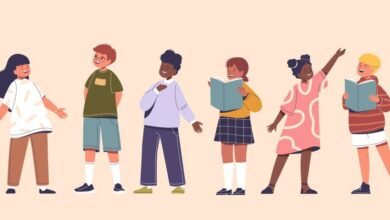
Lessons from Reform to Equal Rights and an accompanying online exhibit introduce students to this aspect of the Civil War through photos and writing by civil war soldiers and nurses. The lessons also examine the institutions that were created to serve disabled veterans and encourage students to consider the experiences of disabled veterans today.
2. Immigration
A 1913 photograph from Ellis Island shows a line of immigrants waiting as a U.S. inspector conducts eye exams. According to Cairn, this photo is often used in teaching immigration history without acknowledging that it’s also a disability story. Pointing that out can spark discussions that strengthen students’ historical thinking skills. “Why would they keep people out? Because they have an eye disease,” Cairn explained. “And so, tracing that back and saying, well, where was the where did that come from? How was that set up? Then you can go back to the legislation.”
The Reform to Equal Rights lesson that includes this photo recommends that students also analyze a photo of immigrants traveling by ship, a political cartoon, an excerpt from the 1882 Immigration Act, and a photo of the chalk marks used by Ellis Island inspectors to identify physical or mental health issues.
3. Eugenics in the Progressive Era
In the 20th century, state agencies forcibly sterilized 70,000 people with mental illness or disabilities, though those labels were often dubious. Forced sterilization came into practice through efforts of the American eugenics movement and was upheld as legal in the 1927 Supreme Court case Buck v. Bell. Eugenicists used flawed science to promote the idea of societal “improvement” by controlling who could reproduce. These practices continued into the 1970s in some states. A Reform to Equal Rights lesson for high school students explores eugenics history through news articles and other historical documents with arguments for and against forced sterilization. It also touches on North Carolina’s recent program to compensate victims of forced sterilization.
Cairn said these resources have been used by teachers who hadn’t been teaching about eugenics when covering the Progressive Era, as well as teachers who wanted to add information about resistance to eugenics. “I don’t expect teachers to be adding a whole bunch of content,” he said. “But thinking about, ‘OK, can I tweak what I do on the Progressive Era and come at it from this perspective?’”
Ross Newton is a history teacher who advised on the Reform to Equal Rights curriculum. He has taught his students at HEC Academy, a special education high school in Massachusetts, the eugenics movement. Newton acknowledged that some parts of disability history, like this one, “can be rather bleak.” But that doesn’t mean young people don’t want to learn it. “I think the students were really intrigued to learn kind of the hard history and the connection to the present,” he said.
Making connections to the present can include reading about ongoing efforts to memorialize victims, some of whom are still alive, as well as what Newton called “student-led civic and research projects.” These projects, which can be done for any topic in disability history, can explore such questions as:
– Where did this occur in my community?
– How did activists and allies respond?
– How does this history relate to ongoing struggles for civil rights by persons with disabilities?
– How can we share these stories?
After teaching his students about the eugenics movement, Newton asks them why it’s important to learn. Many respond that the policies and practices were dehumanizing or that they don’t want history to be repeated. “It’s this emotional response for students,” Newton said.
4. Civics
Civics presents many opportunities to teach disability history. Wendy Harris, a teacher at Metro Deaf School in Minnesota and advisor on the Reform to Equal Rights curriculum, teaches her civics students about a month-long sit-in known as the 504 protest. In her classroom, it’s part of larger discussions on how people make change in society.
In April 1977, people with various disabilities occupied federal office buildings to demand action on section 504 of the Rehabilitation Act of 1973. That law required federally funded programs to ensure equal access to employment and education for individuals with disabilities. But three years later, regulations for enforcing the law had not been published. The 504 protest started in multiple cities, and in San Francisco it lasted 26 days before the Carter Administration signed the regulations.
Harris has used photos, video and newspaper clips to help bring the 504 protest to life for students. They ask questions like: How did people shower during the sit-in? How did they get food? (The Black Panther Party helped with that one.) Learning those kinds of details can lead to deeper connections for her students. “There are some video clips [where] there’s Deaf people, and they’re like, ‘Wait a minute, they’re signing,’” Harris said. “It didn’t occur to them because I didn’t say it was a Deaf protest. I said it was people who couldn’t access the building, couldn’t access jobs. But it’s the intersectionality. It’s the cross-identity movement that sometimes surprises students.”
Newton agreed that primary sources bring stories of disability activism to life in the classroom. “It’s really powerful to read the words. It’s really powerful to look at images of people in a sit-in and ask, what are they doing? Why are they doing this?”
That perspective also allows students to see the agency of individuals with disabilities throughout history, according to Cairn. “There are so many great stories of people with disabilities who have taken the leadership in their communities on all kinds of levels to help make the world a better place for people with disabilities,” he said. “For [students] to be able to see that … really enriches an understanding of civic life.”
5. Education history
The Rights to Equal Reform curriculum includes lessons about the 19th century origins and criticisms of four types of institutions: asylums for people with mental illness, schools for people with developmental disabilities, schools for the Deaf and schools for the blind.
For Benson, the special education administrator, that history was very present when she started her career teaching in a residential facility, which had a connection to a former state hospital. Though she taught English, Benson loved history. She began researching the institutions that had previously housed and educated people with disabilities in her community and shared what she learned with students.
“It was important for them to understand why we were where we were, how we got there, and what things had been like prior for kids who had the same issues that they did and what things could have looked like,” Benson said. “That gave them a better understanding of how to relate to their own disability and how to advocate for themselves.”
In her early teaching years, Benson’s students often weren’t aware that they had individualized education plans or what that meant. So she taught them about each section of the plans and what resources were available to them. “They were teenage boys, so they responded like teenage boys,” Benson recalled. But years later, many of them came back to her and said the resources she taught them about helped them go to college, get on-the-job training or ask for disability accommodations at work.




